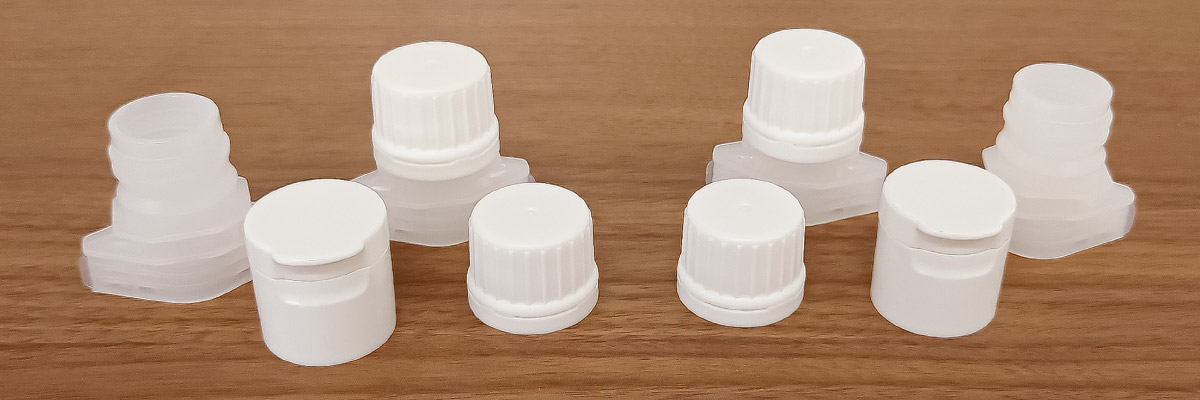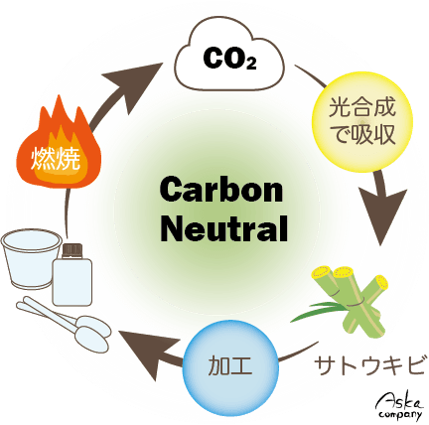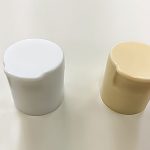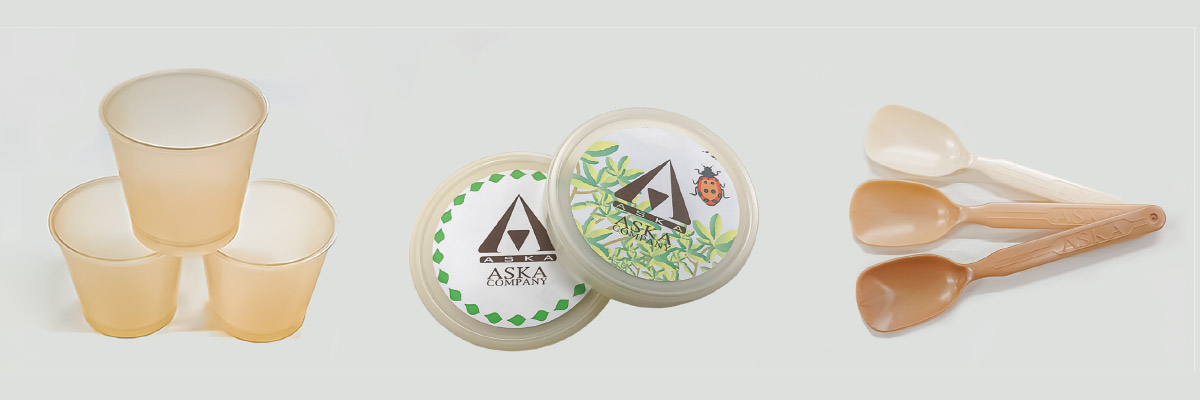Toward mass balance method and ISCC certification
ISCC certification is required in the supply chain to manufacture and sell biomass plastic products using the mass balance method.
Aska Company has started working with a project team to obtain ISCC certification.
We will post more information about the mass balance method and our progress in obtaining ISCC certification on our blog in the future.
Current list of environmentally friendly items
Carbon Neutral and Biopolyethylene Product Offerings
Disposing of plastic generates CO2. Plants grow by absorbing CO2.
Using these plants as raw materials for plastics, we can recycle CO2 and reduce CO2 emissions to practically zero.
Biopolyethylene is not different a lof functionally from regular plastics. Aska Company offers spout made from bio-polyethylene.

-

-
カーボンニュートラルのバイオマス樹脂を使用した環境配慮成形品の試作
バイオマスプラスチックとカーボンニュートラル これまでアスカカンパニーでは、プラスチック使用量削減の取り組みとして、製品の薄肉化を図ることで、環境対応に取組んできました。 また2015年には、超薄肉成形の生産・品質管理技術で「ひょうごNo1ものづくり大賞」を受賞させていただいた実績もございます。 そして、この度、環境に配慮したプラスチック製品の試作をはじめました。 原料には、植物由来のプラスチックとなるバイオマスプラスチックを使用しています。 このバイオマスプラスチックはカーボンニュートラルの考え方で生産された、環境に配慮した樹脂となります。 カーボンニュートラルとは? 現状の日本ではプラスチックの大半はサーマルリサイクルという形で、焼却処理による熱還元を行っています。 プラスチックの基材には炭素が含まれているため、焼却処理では二酸化炭素が発生してしまいます。 発生する二酸化炭素に対応するのが植物となります。 植物は二酸化炭素を吸収して成長します。 その植物がバイオマスプラスチックとなることで、二酸化炭素が循環する形となります。 実質二酸化炭素がプラスマイナスゼロになる、という考え方がカーボンニュートラルとなります。 カーボンニュートラル成形品 バイオポリエチレンの作成方法 弊社のカーボンニュートラル対応のバイオポリエチレンは、サトウキビを加工したものを使用しています。 このバイオポリエチレンの製造工程では、まずサトウキビから糖を抽出、それを発酵させてバイオエタノールを生成します。 そこから取り出したエチレンからバイオポリエチレンが作られます。 通常石油からエチレンを取り出す工程がサトウキビを起点としたものに置き換わるということです。 バイオポリエチレンの特徴 バイオポリエチレンは原料や工程が違っていますが、石油由来のポリエチレンとほぼ同等の物性を持っています。 石油資源の削減や二酸化炭素の削減ができるため、環境負荷への対応が可能なプラスチック資源となります。 カーボンニュートラルのバイオポリエチレンを使用した試作 植物由来のバイオポリエチレンを使用し、弊社AS16ヒンジキャップ(2.05g)にて試作を行いました。 多少の成形上での調整はありますが、出来上がった成形品は通常のプラスチックとそん色ない外観と機能を持っています。 ※機能確認・品質確認はお客様の方でお願いしております。 環境に配慮したプラスチック製品の導入を検討されている方は、是非ご相談ください。
続きを見る
-

-
サトウキビ由来94.5%で出来たプラスチック!
環境にやさしい『ほぼ植物由来』のプラスチック成形品 アスカカンパニーのASスパウトで植物由来94.5%で出来たプラスチックで生産を開始しました。 化粧品や洗剤や食品用途など幅広い分野でおなじみのフィルム包装容器 スタンディングパウチ用スパウトです。 サトウキビ由来で出来たポリエチレン(プラスチック)で二酸化炭素の排出削減を可能に出来ます。 石油由来のポリエチレンは →ナフサ →エチレン →ポリエチレン の順で出来上がります。 サトウキビ由来のポリエチレンは →エタノール →エチレン →ポリエチレン の順となります。 石油由来との差は石油由来ではナフサから作りますが サトウキビではエタノールからポリエチレンを作ります。 アスカカンパニーの工場で3日間連続生産を行い、品質並びに生産性の確認を行い、製品化されます。 このサトウキビ由来のプラスチックは、サトウキビは成長の段階で二酸化炭素を吸収しているため、 廃棄物として焼却する際の二酸化炭素排出量をゼロ(カーボンニュートラル)とみなされます。 アスカカンパニーでは様々な二酸化炭素排出削減ならびに開発に取り組んでいます。 カーボンニュートラルについてもっと知りたい方はこちらを参照ください
続きを見る
Molding Prototype Using Rice Resin
Rice Resin® is a plastic that effectively utilizes biomass resources made from inedible rice (for processing, waste rice, etc.) and surplus products such as resource rice and food loss.
It has the advantage of being produced and supplied in Japan, where rice is a staple food.
When we tried molding the product, we could smell the delicious aroma of rice in the air due to the presence of rice in the molding area, and the smell remained for a while after molding.


-

-
ライスレジン®のご紹介(ASKA MARKET NEWS 2021年1月号 第308号)
国産のバイオマスレジン ライスレジン® での プラスチック試作成形の取り組み いつもマーケットニュースをご覧いただきありがとうございます。 弊社では日々最新技術のサーチに努めており、今回はライスレジン®のご紹介をさせていただきます。 ライスレジン®とは? ライスレジン®は、食べられないお米、非食用の「資源米」等を原料としたバイオマスプラスチックです。 オレフィン系樹脂との相溶性がよく、加工適性に優れ、幅広い用途で成形が可能。 バイオマス特有の優しい風合いが特徴で、原料の機能が樹脂に影響し、多様な効果を発揮します。 ライスレジン🄬のメリットは? 純国産バイオマスプラスチック・・・石油相場に左右されない国産バイオマスで安定供給も。 実際に、バイオマス度70のライスレジン®樹脂で、射出成形品で試作をしてみました。 実際の試作品 左がPP(ポリプロピレン)100%で成形したもの。 右はPP:ライスレジン(お米70%)=25:5=83.3%:16.7%の配合で希釈したもの。 実際のお米の割合は11%になります。 マスターバッチを混ぜて、木質感を出してみました。ライスレジン®の自然な質感も合わさって、より優しい風合いになりました。 ヒンジキャップでも試作してみました。 左がPPにマスターバッチを添加したものになります。 右は先ほどと同様にお米率11%になるように、PP:MB:ライスレジン=25:1:5(実質の割合80.6%:3.2%:16.1%)で成形しました。 写真ではお伝えできないですが、ヒンジキャップのパッチン感も損なわれずに成形できました。 微妙にお餅のような匂いがするのも、ライスレジン®ならではです。 アスカカンパニーでは、環境に配慮した樹脂での成形も色々と試しております。 ご協力: 株式会社バイオマスレジン南魚沼 https://www.biomass-resin.com/ ASKA MARKET NEWS 2021年1月号のダウンロ ードはこちらをクリック
続きを見る
MBBP (Marine Biodegradable Biomass Plastic) Compound Prototype
Aska Company is participating in the MBBP development platform.
We are trying to develop molding technology using MBBP in the molding field.
In this trial molding, we evaluate the molding performance and functions of the molded product by molding the compound made by the MBBP participating organizations.
For more details, please check our blog.

海洋生分解性シリーズ
- 海洋生分解性バイオマスプラスチック開発プラットフォーム参画のその後6
- 海洋生分解性バイオマスプラスチック開発プラットフォーム参画のその後5
- 海洋生分解性バイオマスプラスチック開発プラットフォーム参画のその後4
- 海洋生分解性バイオマスプラスチック開発プラットフォーム参画のその後3
- 海洋生分解性バイオマスプラスチック開発プラットフォーム参画のその後2
- 海洋生分解性バイオマスプラスチック開発プラットフォーム参画のその後1
- 海洋生分解性プラスチック開発プラットフォームへ参画
Marine-Biodegradable Biomass Plastics(MBBP) MBBP プラットフォーム代表幹事
宇山 浩(大阪大学大学院工学研究科・教授)
徐 于懿(大阪大学大学院工学研究科・助教)
Trial Production Using Tapioca-Derived Starch
There are various types of starch, but the Aska Company blended starch produced from tapioca with PE, PP, and PS and made a prototype to evaluate its functions.
That is an attempt to reduce petroleum resources by effectively utilizing tapioca, a plant-derived resource.
The use of starch may cause a slight decrease in impact resistance.
In addition, the molded product has character. For example, it has a starch-derived smell and a starch-like yellow to brown color tone.

Please check our blog
We update information related to environmental resins on a timely basis.
We also have samples and other materials available, so please let us know if you want to see them in person.